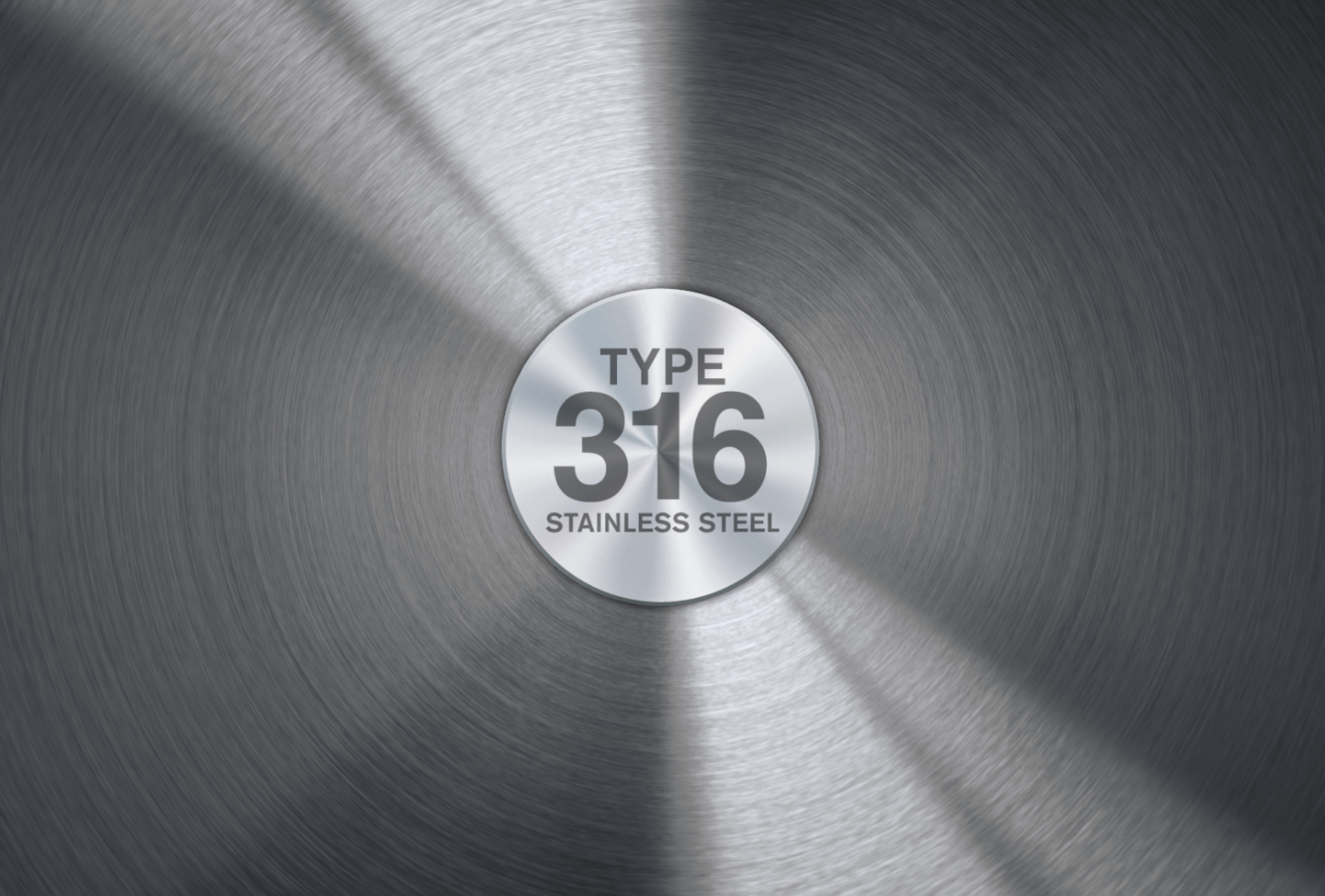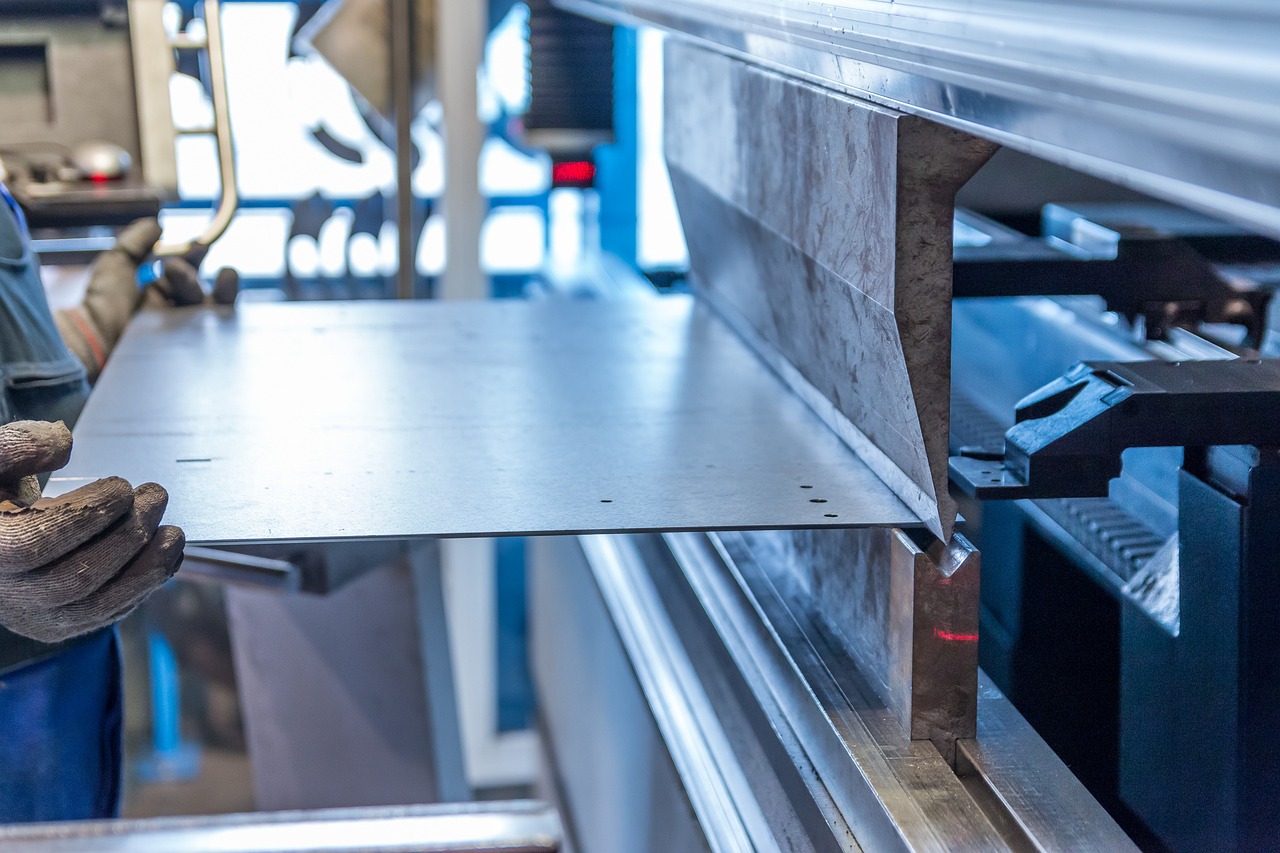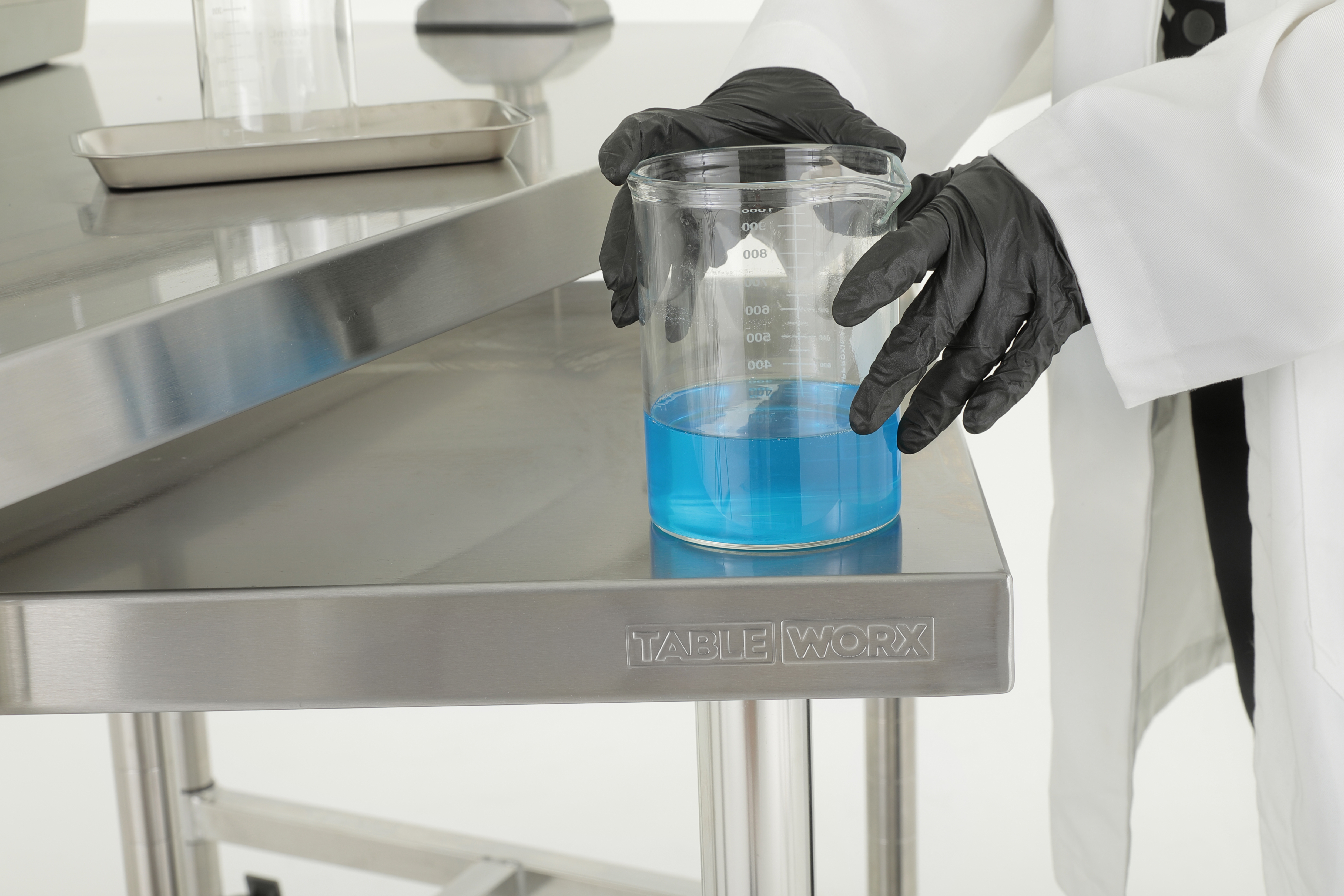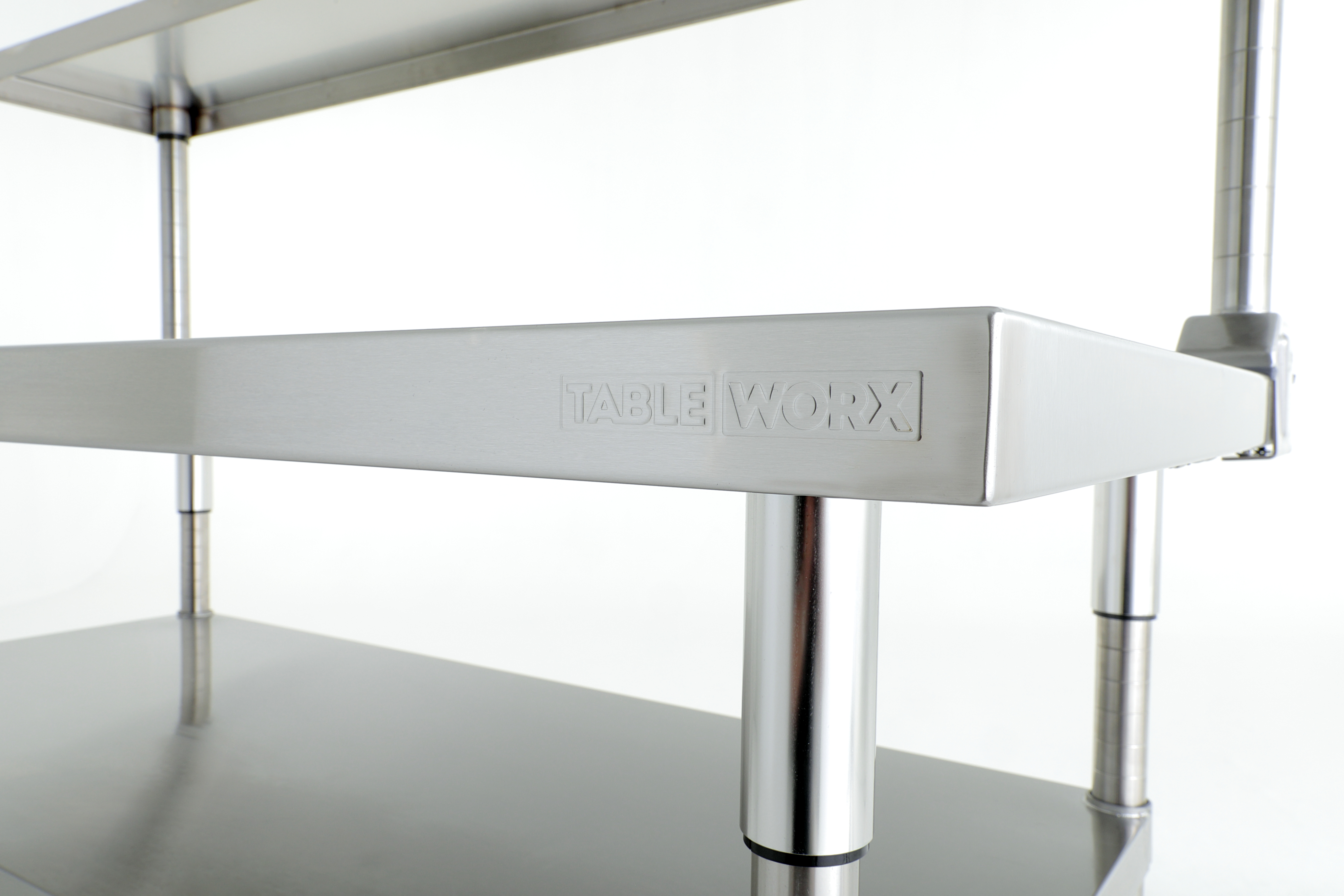For many industries, the choice of work surfaces is critical. When choosing an appropriate material, you must consider durability, cleanability, and longevity.
Stainless steel has long been a preferred choice for work surfaces because of its inherent strength and resistance to corrosion. However, not all stainless steel is created equal. With various grades available, understanding the specific properties of each is essential for making informed decisions.
304 stainless steel is the most common alloy used in everything from utensils to exhaust manifolds. However, certain applications require a more corrosion-resistant work surface. In those instances, we recommend 316 stainless steel.
Keep reading to learn more about 316 stainless steel, how it compares to 304 stainless steel, and why it is particularly suited for demanding environments such as labs, healthcare facilities, commercial kitchens, and beyond.

How is Stainless Steel Made?
Stainless steel is a versatile and widely used material known for its exceptional strength, durability, and resistance to corrosion. At its core, stainless steel is an alloy primarily composed of iron, carbon, and chromium. It may also contain other elements such as molybdenum, nickel, manganese, and nitrogen.
It all starts with steel, which is formed by combining iron and carbon. This increases its overall hardness and, within specific ranges, boosts its strength (compared to iron). Steel typically contains up to 2% carbon and may include other elements to enhance its properties. These additions create various steel grades.
While steel is more durable than iron, it is still susceptible to oxidization when exposed to air and moisture.
Adding chromium to steel creates stainless steel, which is much better at resisting rust and high temperatures. The added chromium reacts with the oxygen in the air to form a passivated layer of chromic oxide. This layer serves as a protective barrier between the alloy and the environment, providing stainless steel with its renowned durability and wide temperature range.
Properties of Stainless Steel
Stainless steel is known for its exceptional properties, making it the preferred—and often required—work surface in various industries.
Here are some of the properties that make it a popular material:
- Corrosion Resistance: Thanks to the chromium content, stainless steel forms a passive layer of chromic oxide that protects it from rust and corrosion. This layer can self-repair if damaged—if there is sufficient oxygen in the environment.
- Heat Resistance: Maintains strength and resists scaling at high temperatures. Its melting point ranges from 2,550 to 2,790 °F (1,400 to 1,530 °C), depending on the grade and alloy composition.
- Strength: Thanks to its alloy composition, stainless steel is a strong material, and its tensile yield strength varies depending on its alloys and whether it has been strengthened via cold working. Stainless steel provides excellent mechanical properties, making it suitable for heavy-duty applications and many manufacturing processes.
- Aesthetic Appeal: Stainless steel has a sleek and modern appearance, which is both functional and aesthetically pleasing.
- Cleanability: Besides looking clean, stainless steel has a smooth surface that is easy to clean and maintain. This contributes to its widespread use in hygienic applications such as healthcare facilities and clean room environments.

Grades of Stainless Steel
Stainless steel comes in different grades, each designed for specific uses and conditions depending on its composition and properties. The grades depend on their chemical content, physical properties, metallographic structure, and functional characteristics.
The mechanical properties fall into four families: ferrite, martensite, austenite, and duplex. These families are further categorized into grades describing the properties of the alloys used to produce them.
These variations in composition and processing result in unique physical properties, such as corrosion resistance, strength/durability, and magnetic behavior. Each change, adjustment, or addition to an alloy impacts the performance of a grade of stainless steel.
Understanding the differences between these grades is crucial for selecting the right material for your needs, as they are not all created equal.
There are over 60 grades of stainless steel. Here are a few of them:
300 Series Stainless Steel
When nickel is added, it is often called 300 Series, the most widely used category of stainless steel. These grades are austenitic, meaning they have a face-centered cubic crystal structure that enhances their strength and corrosion resistance.
The presence of nickels, in addition to chromium, is a defining characteristic of this series, improving its overall performance. 300 Series alloys resist corrosion, maintain strength at high temperatures, and are easy to maintain.
The two most widely used grades of 300 Series stainless are 304 and 316.
400 Series Stainless Steel
Another common type of stainless steel is 400 Series. These steels are martensitic and contain a higher carbon content, providing moderate magnetic properties. While these grades are known for their high strength and wear resistance, they offer less corrosion resistance than the 300 Series.
430 stainless steel is common in food service industries where less corrosion resistance is acceptable, providing a cost-effective option for certain applications, including stainless steel prep tables.
Other Notable Grades
While the 300 and 400 Series are the most common, other stainless steel grades are ideal for specialized applications.
200 Series stainless steels are austenitic and contain manganese and nitrogen instead of nickel, making them less expensive but also less corrosion-resistant than the 300 Series.
2205 Duplex Stainless Steel combines austenitic and ferritic properties. They contain higher levels of chromium, nickel, molybdenum, and nitrogen, which provide higher strength and excellent resistance to stress corrosion cracking.
304 vs 316 Stainless Steel
When it comes to heavy-duty stainless steel tables, carts, and shelving, choosing between 304 vs 316 stainless steel is common, particularly in healthcare, commercial, and industrial applications.
300 Series stainless steel is known for its austenitic structure, which provides excellent mechanical properties and corrosion resistance. 304 and 316 stainless steel both contain high levels of chromium and nickel, which provide the material with excellent resistance to heat, abrasion, and corrosion. They also have excellent welding and forming properties, giving them applications in many industries. Both 304 and 316 stainless steels are considered surgical or medical-grade stainless steels and are considered the most common.
While similar, their compositional differences lead to distinct performance characteristics, making each suitable for specific applications. The most notable difference is the addition of molybdenum, which is in 316 but not 304. This alloy drastically enhances corrosion resistance, especially in more saline or chloride-exposed environments.
SAE 304 Stainless Steel
- Contains approximately 18% chromium and 8% nickel.
- Often referred to as 18/8 stainless steel.
- Sometimes, it contains small amounts of carbon, manganese, and silicon.
- Offers good corrosion resistance and is suitable for various environments, including exposure to chemicals and moisture.
SAE 316 Stainless Steel
- Contains 16-18% chromium, 10-14% nickel, and 2-3% molybdenum.
- The addition of molybdenum significantly enhances its resistance to chlorides and other corrosive elements.
- Provides superior corrosion resistance, especially against chlorides and other industrial solvents.
- Offers slightly better overall strength, particularly at elevated temperatures, and is resistant to pitting and crevice corrosion.
- Maintains stability and strength at higher temperatures.
Advantages of 316 over 304 Stainless Steel
While 304 and 316 stainless steels offer excellent corrosion resistance and durability, 316 provides an advantage in enhanced resistance to chlorides and other corrosive substances.
The presence of molybdenum and higher nickel content provides 316 stainless steel with higher resistance to a wide range of chemicals, including sulfuric acid, bromides, iodides, and fatty acids, at high temperatures. This makes 316 the preferred material for equipment and surfaces in industries where exposure to aggressive chemicals and frequent cleaning with caustic agents are common.
Many industries, ranging from food service and marine to chemical and pharmaceutical, are specifying 316 given its durability for more corrosive and frequent cleaning. Cleanrooms face more frequent and caustic cleaning protocols, which require a material that can withstand harsh chemicals.
The product contact surface and equipment feet in contact with flooring are the most susceptible to caustic substances, including but not limited to cleaning agents such as bleach, ammonia-based cleaners, hydrogen peroxide, and Sporeklenz.
Because 316 is more robust to chloride exposure, it is often called marine-grade stainless steel, as it stands up to the salt (sodium chloride) in seawater better than other stainless alloys.

316 Stainless Steel Applications
316 stainless steel work surfaces are highly prized for their exceptional properties, making them ideal for many demanding applications. If you're looking for a surface material that provides superior corrosion resistance (particularly against chlorides and aggressive chemicals) and outstanding durability and strength, in addition to a smooth, easy-to-clean surface, 316 is a premium option for work tables, shelving, utility carts, and more.
Commercial Applications
Cleanrooms, pharmaceutical manufacturing, biopharma facilities, vivarium facilities, and laboratories require sterile, durable, and corrosion-resistant surfaces. 316 stainless steel work surfaces provide the necessary resistance to aggressive chemicals and frequent sterilization procedures.
Commercial applications for 316:
- Biotech and pharmaceutical manufacturing facilities
- Cleanrooms and vivariums
- Compounding pharmacies
- Laboratory workstations and equipment
- Chemical processing environments
- Autoclave-compatible storage and transport systems
- Facilities requiring frequent sterilization and caustic cleaning protocols
Healthcare Applications
In healthcare environments, 316 stainless steel work surfaces may be preferred in pharmacies and operating rooms (OR) because they offer unparalleled hygiene and durability. Their enhanced resistance to corrosion from exposure to various chemicals and cleaning agents makes them suitable for sterile work areas, and their smooth surface helps prevent contamination and supports the rigorous cleaning protocols necessary in healthcare settings.
Healthcare applications for 316:
- Hospital operating rooms (ORs)
- Sterile processing departments (SPDs)
- Pharmacies and medication prep areas
- Diagnostic labs and pathology departments
- Medical device manufacturing
- Areas exposed to disinfectants like bleach, hydrogen peroxide, and Sporeklenz
Foodservice Applications
In addition to withstanding caustic chemicals in lab and healthcare environments, 316 stainless steel is also beneficial when dealing with acidic materials, such as tomato sauce, and organic materials, like meat processing facilities or even butcher shops. Additionally, as a "marine grade" stainless steel, 316 is ideal for kitchens and food prep areas near the sea or on ocean-going vessels, where exposure to seawater is inevitable.
Foodservice applications for 316:
- Coastal or marine kitchens (due to salt exposure)
- Butcher shops and meat processing stations
- High-acid food prep areas (e.g., tomato-based sauces)
- Commercial kitchens with frequent chemical cleaning
- Food transport carts in hygienic environments
Other Things to Consider: Total Cost of Ownership
When comparing 304 vs 316 stainless steel, the latter is undoubtedly more expensive, which can cause some hesitation, especially if it puts a project over budget. However, while 316 stainless steel work tables, carts, and shelves are initially more costly than their 304 counterparts, the total cost of ownership is significantly lower due to their enhanced longevity and durability.
316 offers superior corrosion resistance for environments that require it, reducing the need for frequent replacements and repairs and offering long-term savings. When determining whether you need 316 or if 304 will suffice, consider your spec, your environment, and your cleaning supplies, all of which will help decide whether or not you should invest in 316 stainless steel solutions.

Electropolishing Stainless Steel
One method of improving stainless steel is electropolishing, or e-polishing. This finishing process enhances the performance and longevity of stainless-steel parts by submerging the metal in an electrolytic solution and applying a controlled electric current. The process removes a thin material layer from the surface, producing a microscopically smooth and highly polished finish.
E-polishing enhances stainless steel's natural corrosion resistance by eliminating surface imperfections, reducing the initiation sites for corrosion, and significantly extending the material's lifespan, especially in harsh environments. The smooth surface is also easier to clean and sterilize, which is ideal for industries requiring advanced hygiene levels.
Discover the Benefits of 316 Stainless Steel with Metro
Does your spec call for 316 stainless steel, or do you want to upgrade your efacility? We can help. At Metro, we understand the importance of durable, hygienic, and high-performing work surfaces across various industries, and we have expanded our offerings to meet those needs.
In addition to our standard and all-stainless 304 options, we now offer a full range of 316 stainless steel solutions, including:
TableWorx 316 Stainless Steel Work Tables – Featuring heavy-gauge 316 stainless steel tops and optional cantilevered overshelves.
316 Stainless Steel Carts for Labs and Cleanrooms – Ideal for transporting sensitive materials in demanding environments.
Super Erecta Solid Type 316 Stainless Steel Shelf – Designed for spill containment and built to withstand frequent autoclaving and chemical exposure.
Whether you're outfitting a commercial kitchen, a healthcare facility, or a cleanroom, our 316 stainless steel products are engineered to meet the most demanding environments and stringent hygiene standards.
Ready to Upgrade Your Work Surfaces? Contact us today to discuss your requirements and discover how Metro's 316 stainless steel solutions can benefit your business. Our experts are here to help you make the best choice for your specific application, ensuring you get the quality and performance you need.
